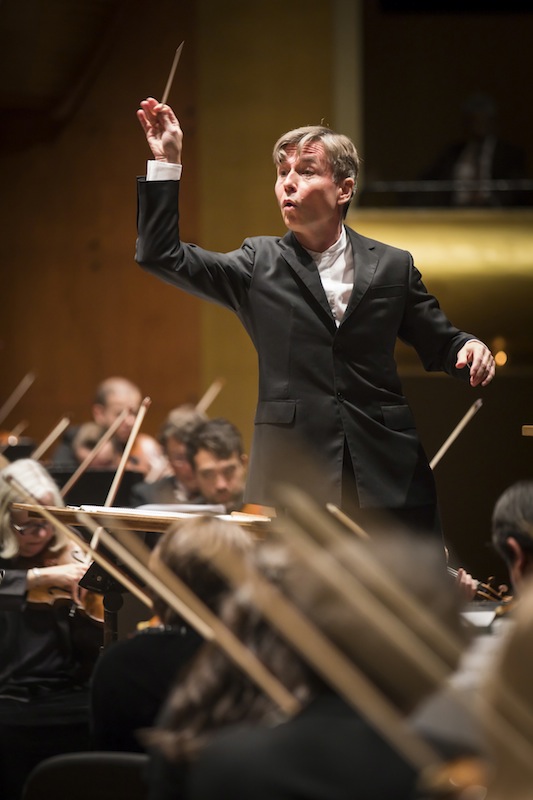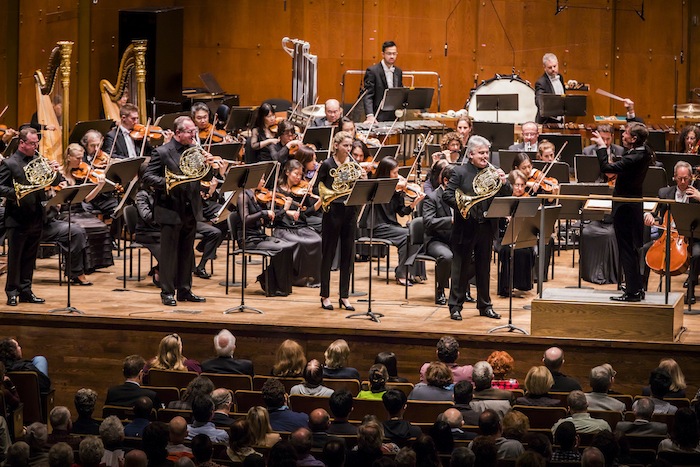Davies premiere, lost-and-found Stravinsky highlight Salonen’s Philharmonic program

Esa-Pekka Salonen conducted the New York Philharmonic Thursday night at David Geffen Hall. Photo: Chris Lee
The New York Philharmonic waxed philosophical Thursday night in heady works by Stravinsky, Tansy Davies, and Richard Strauss—and waxed and waned musically under the baton of Esa-Pekka Salonen.
The program’s headliner was to have been the U.S. premiere of Forest, Davies’s scintillating meditation on humans and nature for four horns and orchestra, a Philharmonic co-commission.
But that was before the announced program’s familiar opener, Beethoven’s Leonore Overture No. 2, was replaced by something utterly unfamiliar–the New York premiere of a recently reconstructed work by Stravinsky: the Funeral Song, Op. 5, composed for a 1909 concert in memory of Niklolai Rimsky-Korsakov, and lost from that date until its re-discovery in 2015. Bringing up the rear, both in program order and musical interest, was a brilliant yet bloodless performance of Strauss’s Also sprach Zarathustra.
Stravinsky himself only dimly remembered his Funeral Song. Dictating his memoirs to Robert Craft half a century later, he recalled that the piece was one of his better works before The Firebird and speculated that the performing parts might still be in the Leningrad Conservatory library. Another half century after that, he was proved right when the parts surfaced during a renovation.
As Salonen and the Philharmonic opened this musical time capsule Thursday night, the deep gong and soft tremolo punctuated by a sudden flash of high winds made one anticipate a lost scene from The Firebird. What followed was anything but a conventional dirge, but something more fragmentary, literally “broken up,” as Stravinsky’s flair for unusual orchestral timbres contended with the young composer’s outside influences.
Tchaikovsky could be heard in the Russian-sounding phrases piling up in anxious sequences, and in the swirl of strings leading to a cymbal crash. Here and there, chromatic harmonies testified to the continuing pull of Wagner even in 1909. But other features, including the oddly spaced final chord, were pure Stravinsky.
The composer recalled the “marked” impression this music made on its first audience and on himself. One can hardly imagine what disciples of the polished Romantic Rimsky-Korsakov made of these enigmatic utterances. If Funeral Song is unlikely to take a place in the repertory next to Petrushka and The Rite of Spring, it nevertheless provided an intriguing glimpse of an emerging master.
Tansy Davies, on the other hand, is well emerged, particularly in her native Britain, where she was named a BBC Young Composer as far back as 1996. On Thursday, as he sometimes does, Salonen invited the composer onstage for a chat while stagehands were setting up for her piece.
As the English composer wrote in the program, she “loved the raw energy” of hunting horns as hunters crashed through the woods. It was, she thought, the kind of energy that could animate a piece about humans’ relationship to nature, from estrangement to the possibility of reconciliation. Like Strauss in Zarathustra, Davies aimed to express philosophical ideas in approachably earthy musical terms.

Photo: Chris Lee
Accordingly, as the piece began, the four horn players standing at the front of the stage yawped furiously, setting the percussion-rich “forest” behind them all a-twitter. Just when the ear began to tire of all the stuttering phrases, the orchestra settled into a gentle undulation of bird song, and the horns responded in long, drowsy tones.
Throughout the one-movement piece, one was reminded that, as the Tristan chord was the sound of the late 19th century and the Petrushka chord that of the early 20th, so the major second—dissonant yet more “open” than the angry-sounding minor second—seems to be the go-to interval for composers so far in the 21st. Davies’s score, and particularly the horn quartet, positively abounded in major seconds, producing a kind of train-horn sound that, in this context, suggested close encounters of the woodsy kind.
Eventually, bass and snare drums laid down a syncopated rhythm, and horns and orchestra moved together in a dance of reconciliation. The horn players even abandoned their keys and valves for a while, playing their instruments “natural” style—forming the pitches with just lips and air pressure, and producing particularly rich-sounding harmonies in the process.
A cadenza for the four horns followed, alternately languid and agitated in mood. The orchestra’s original percussion-colored shimmer returned to close the piece on an enigmatic note, suggesting (again like Zarathustra) that, despite their happy dance together, a gulf still yawned wide between the human and natural worlds.
Horn players Richard Watkins, Katy Wooley, Nigel Black and Michael Thompson, all present or former principal horns of London’s Philharmonia Orchestra, re-enacted their roles in the piece’s world premiere last February with that orchestra. Although Davies gave them few opportunities to play lyrically, their technical virtuosity and dynamic control proved them masters of their difficult instrument and worthy successors of British horn legends such as Dennis Brain. For his part, Salonen evoked the orchestra’s multifarious sounds in palpable 3-D.
With ears thus primed to hear still more philosophy in Technicolor, one was disappointed to hear the brittle, driven performance of Also sprach Zarathustra that followed. It was as if only Nietzsche’s bitterest jibes at humanity were featured in the mechanical “Of Joy and Desire” section or the joylessly waltzing “Dance Song.”
Salonen’s fluid conducting style did draw out some long, taut lines in the early going, and the fugue on the piece’s three-note motto generated a good deal of motoric excitement. The orchestra was technically brilliant throughout, and the terribly high and exposed final wind chords were well timed and tuned.
But without those sensuous Straussian touches—the wildness of passion, the wink of seduction—one pole of this bipolar piece was missing in action.
The program will be repeated 8 p.m. Saturday. nyphil.org; 212-875-5656.






